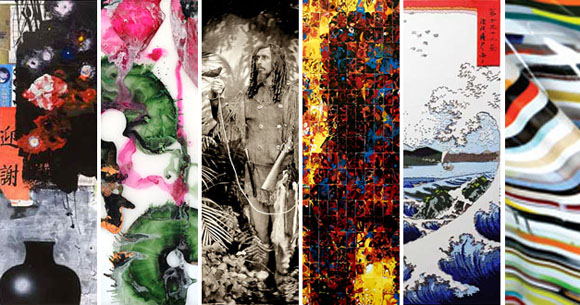 |
Here, in reverse chronological order, are some of the strongest shows Squarecylinder covered in the past year. Note: This recap is not inclusive, comprehensive or even remotely fair. In fact, the list of worthy artists that we didn’t have time to cover is longer than the list of those we did. Among the regrets, I’m thinking in particular of the photographer Nina Zurier whose large-scale (10-foot-long) images shot from moving trains come as close to being cinematic as any still photographs you are likely to see; of Clare Rojas, whose mock-erotic pictures fiendishly subvert the conventions of Indian miniatures; of the tech-heavy Zero One festival in San Jose; and of the masterful and always ambitious canvases of veteran Bay Area painter Christopher Brown. Unfinished business aside, I’m hoping this look back at 2010 – our second year of covering Northern California art — proves Squarecylinder to be worthy of your attention in the year ahead.
.jpg) |
Ian Harvey/Koo Yoo @ JAYJAY. For Ian Harvey and his wife Koo Kyung Sook, collaboration is about wresting order out of manufactured chaos. Harvey specializes in process-oriented abstract paintings that look like time-lapse images of geological events; Koo creates imprints of her body on emulsion-coated photo paper, along with sculptures made of organic matter that address gender issues specific to Korea, her birthplace. In their collaborative works, the artists fuse both sensibilities in wall-sized montages that are as much about virtuoso paint handling as they are about the human condition. Read the full story…
 |
Marcus Linnenbrink @ Patricia Sweetow. Marcel Duchamp predicted that “retinal art” would vanish, and that ideas, stripped of sensuality, would someday rule. His prognostication certainly came true in conceptual art. But for rest of the world, including that of the German-born, Brooklyn-based artist Markus Linnenbrink, the notion doesn’t hold. For Linnenbrink, color isn’t just a means; it’s a riotous end that will likely transfix anyone whose taste runs toward finish fetish and abstraction. For material inventiveness, I can’t think of a show I’ve seen in recent years, that tops this. Read the full story…
 |
 |
 |
 |
 |
 |
 |
 |
 |
 |
 |
David,
Always interesting to see different people’s year’s end list; can’t believe anyone EVER agrees with anyone else’s list. Yeah, too bad Chris’s show at Berggruen didn’t make the cut; easily a better show than several others that were listed.
And David; Luc Tuymans is the worst painter in the history of the world to ever get rich and famous. Absolutely the emperor’s new clothes. On my worst day I could make a better painting than anything in that vacuous SF MoMA show.
But all my opinions aside, I enjoy reading your reviews.
Keep up the good work.
Craig